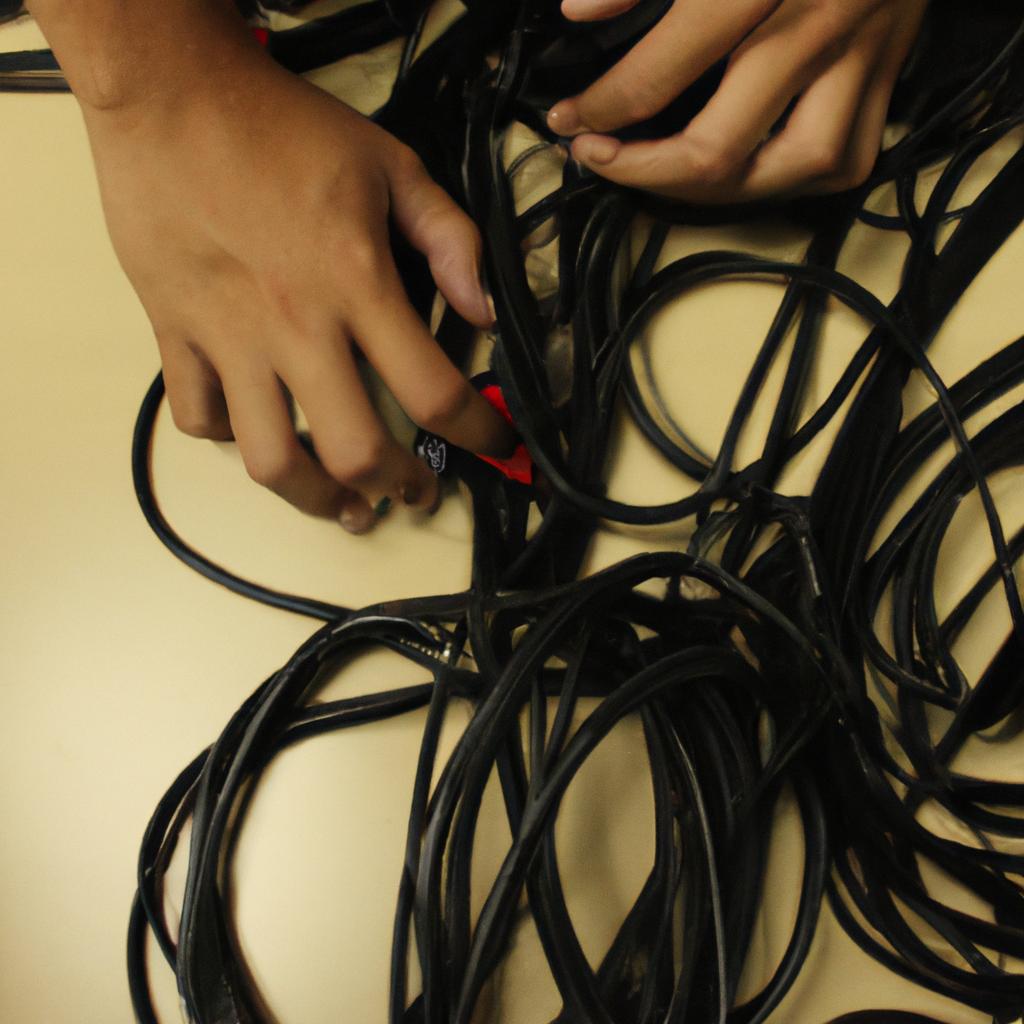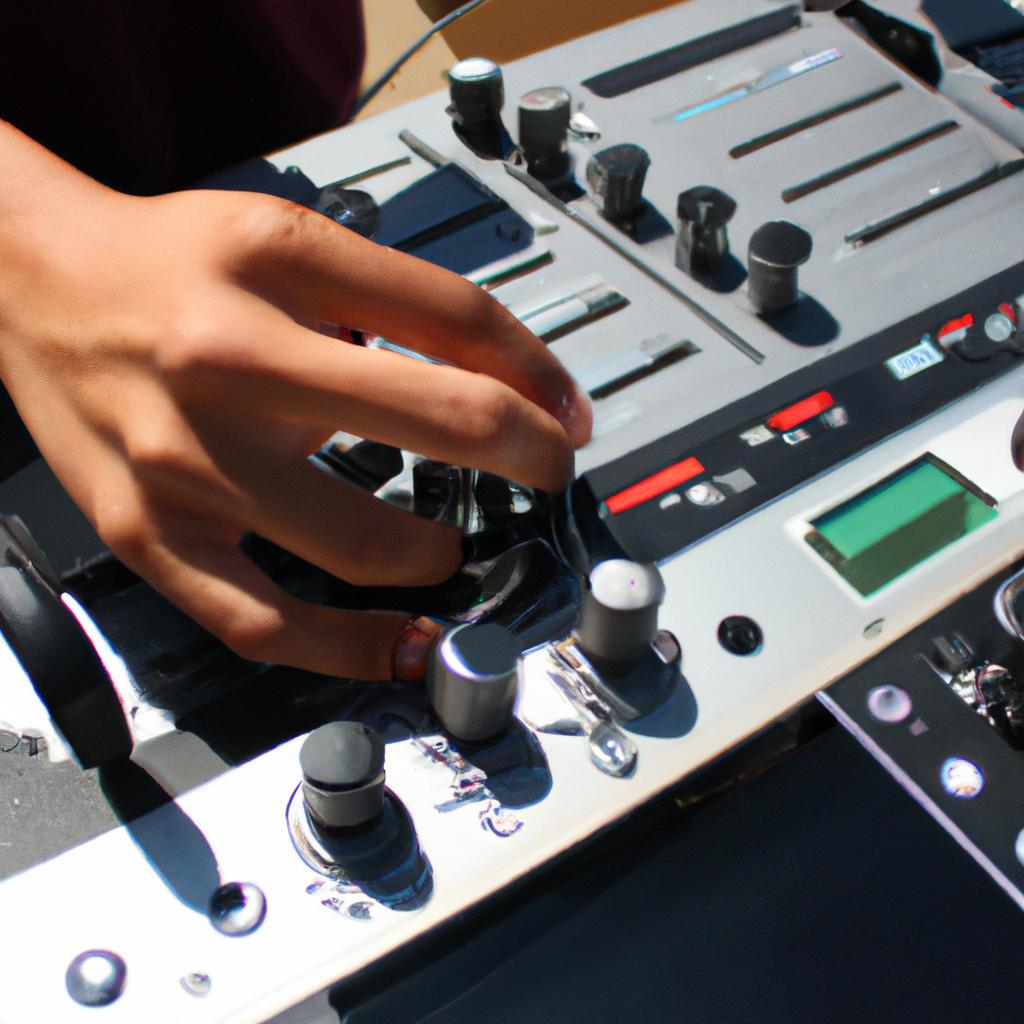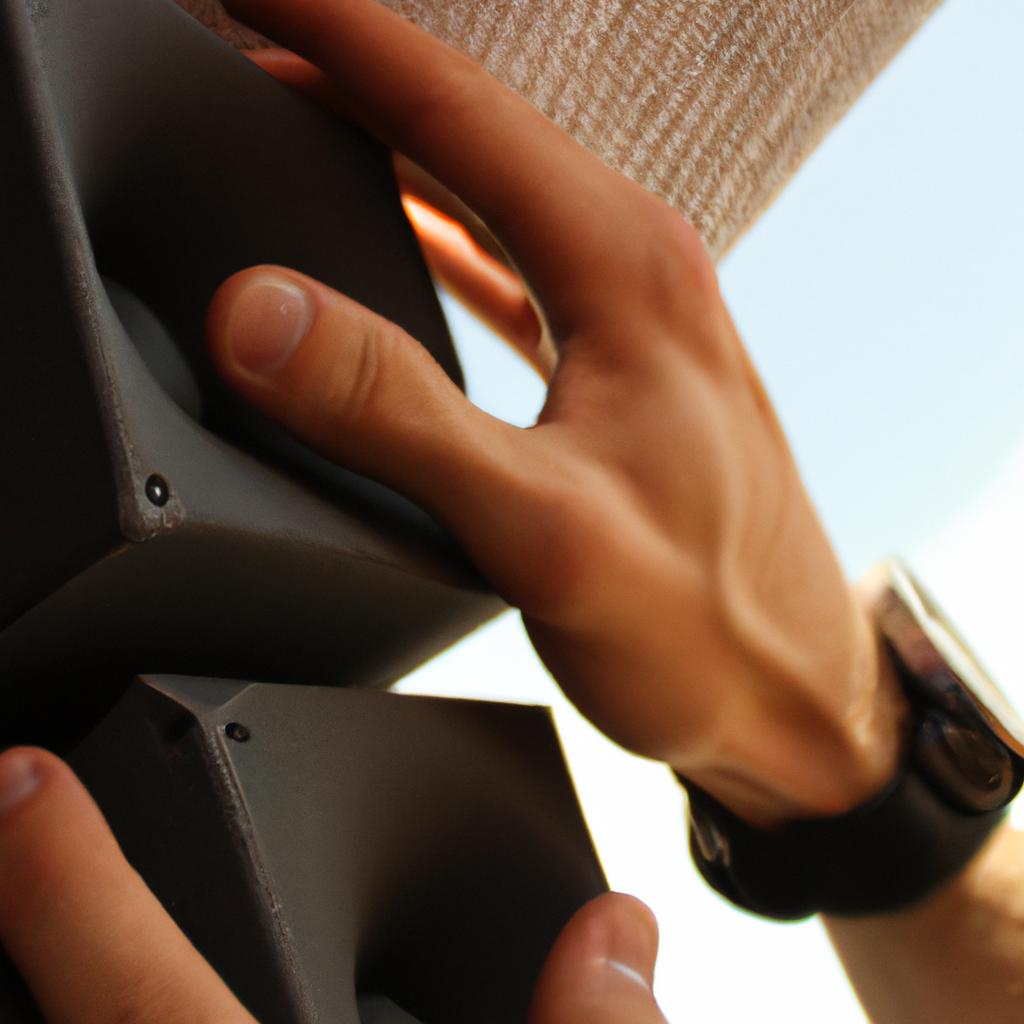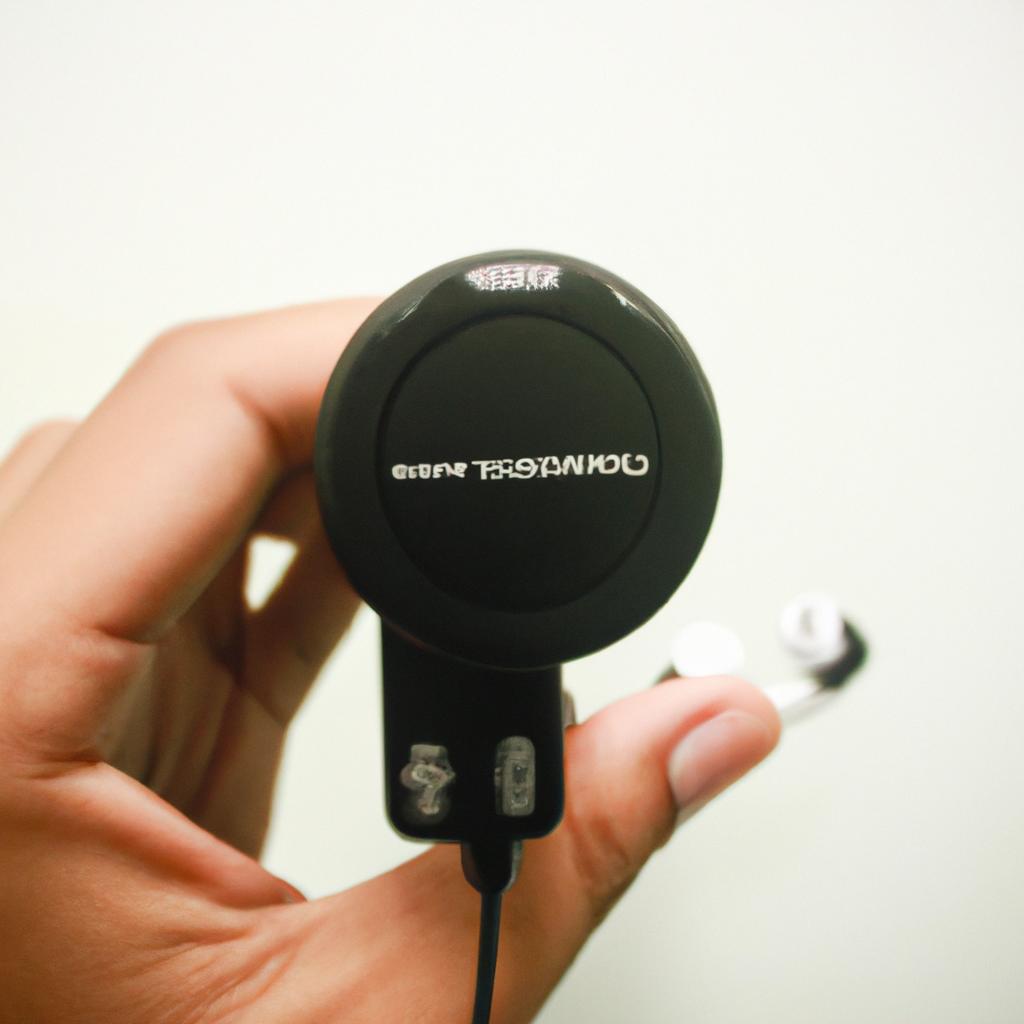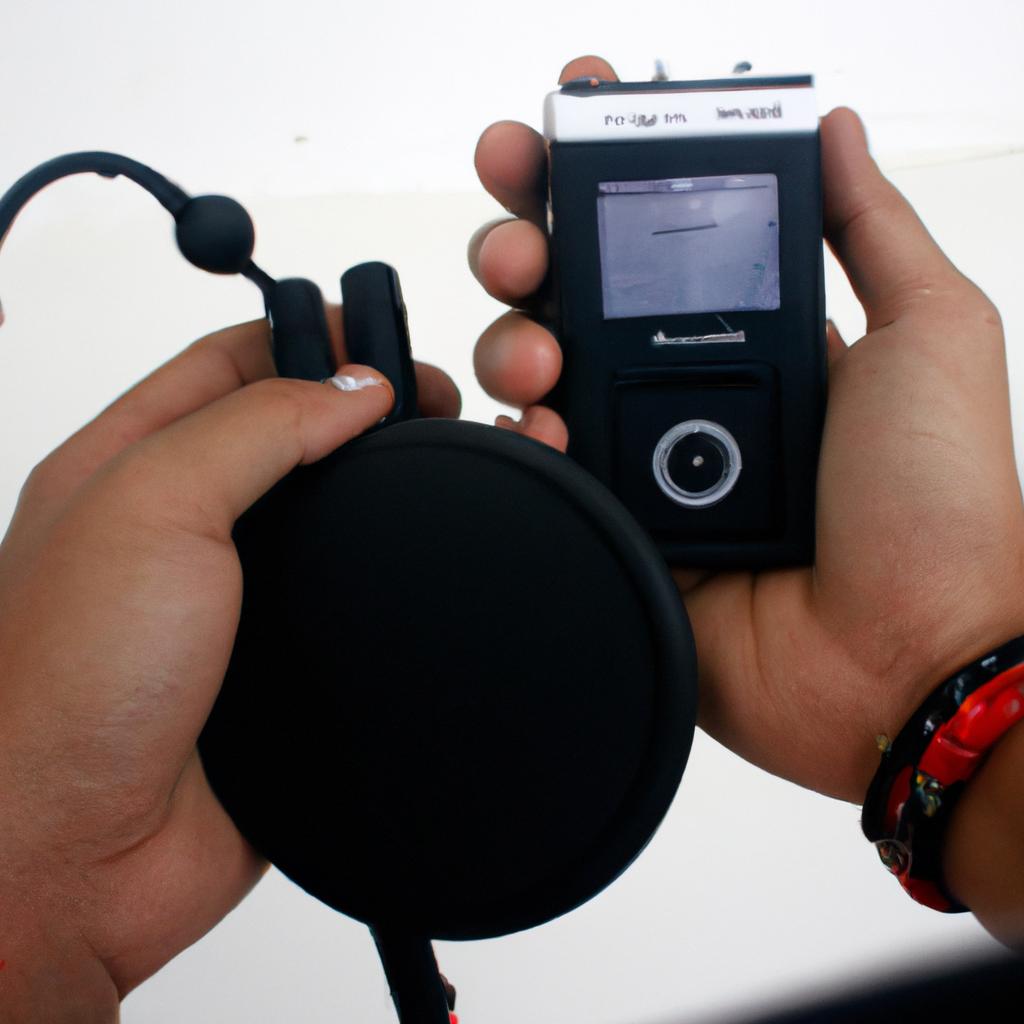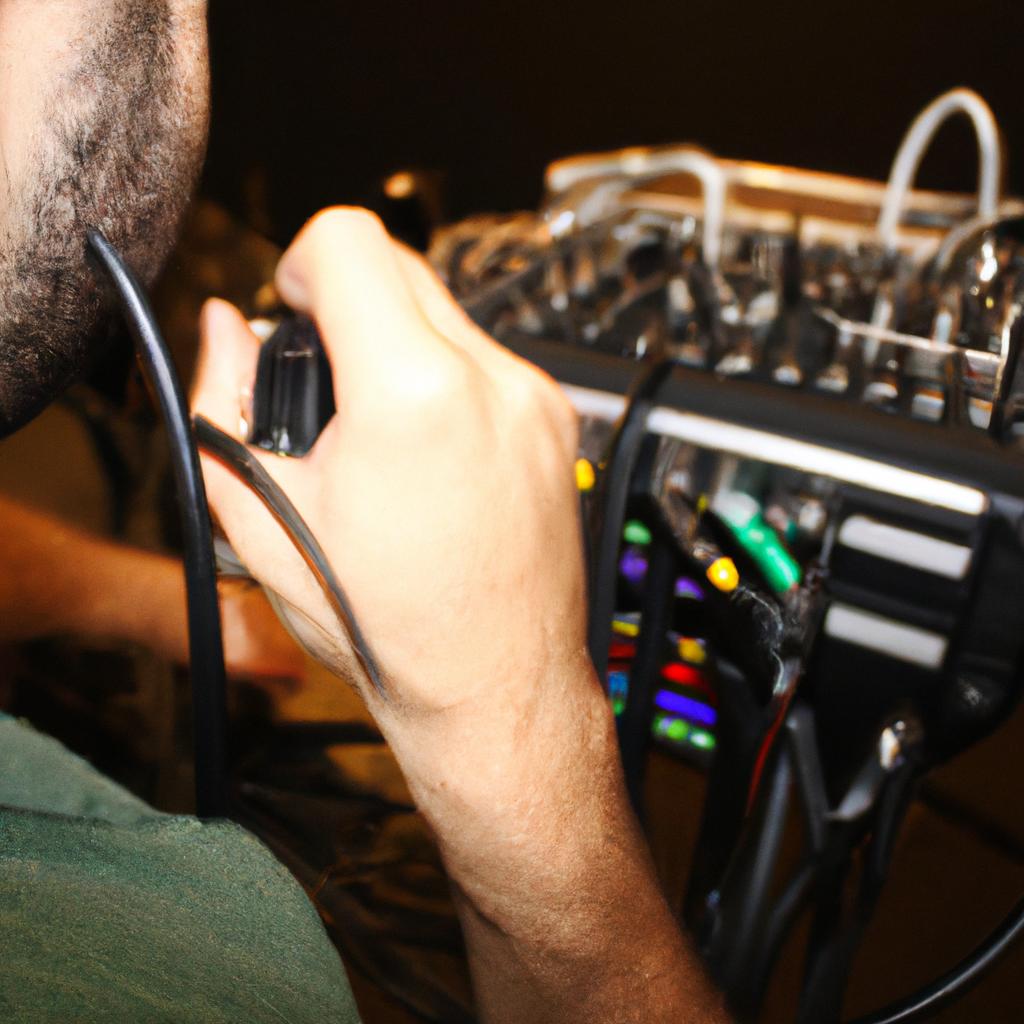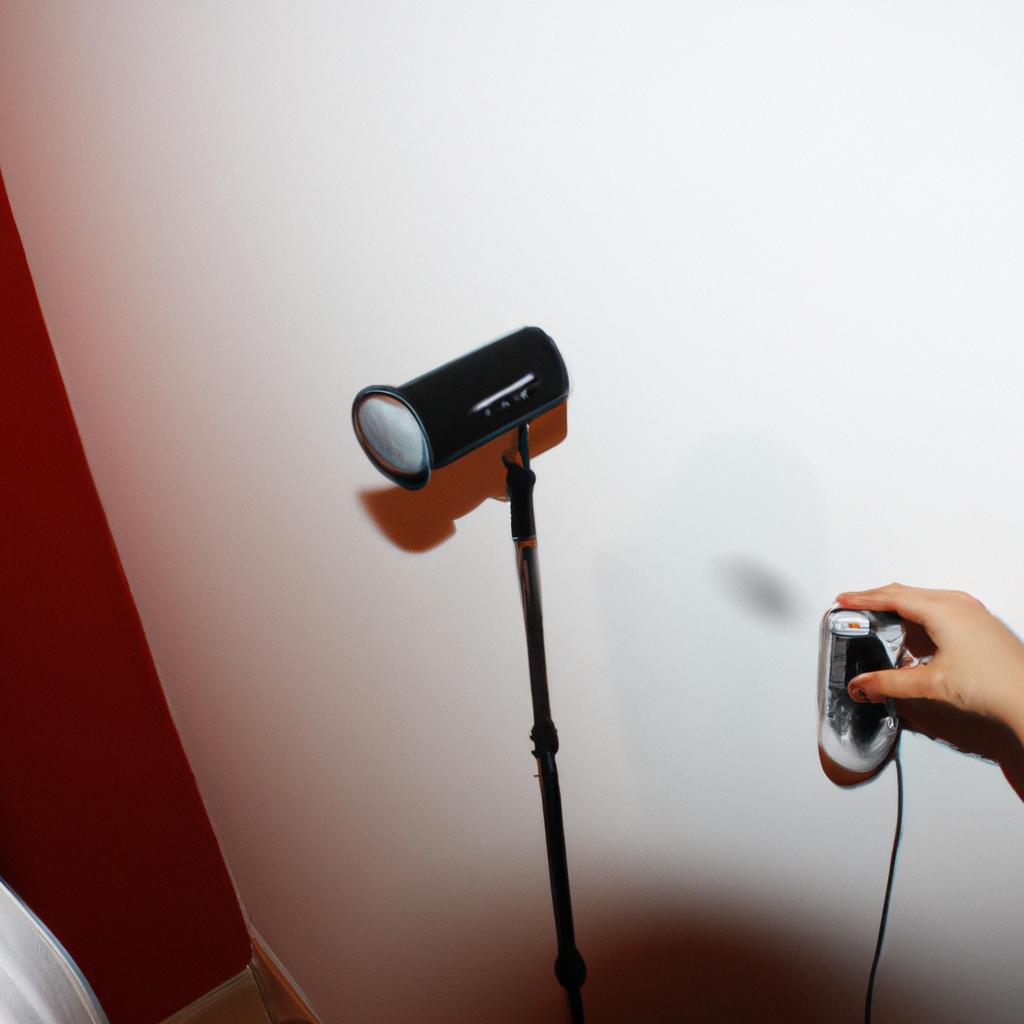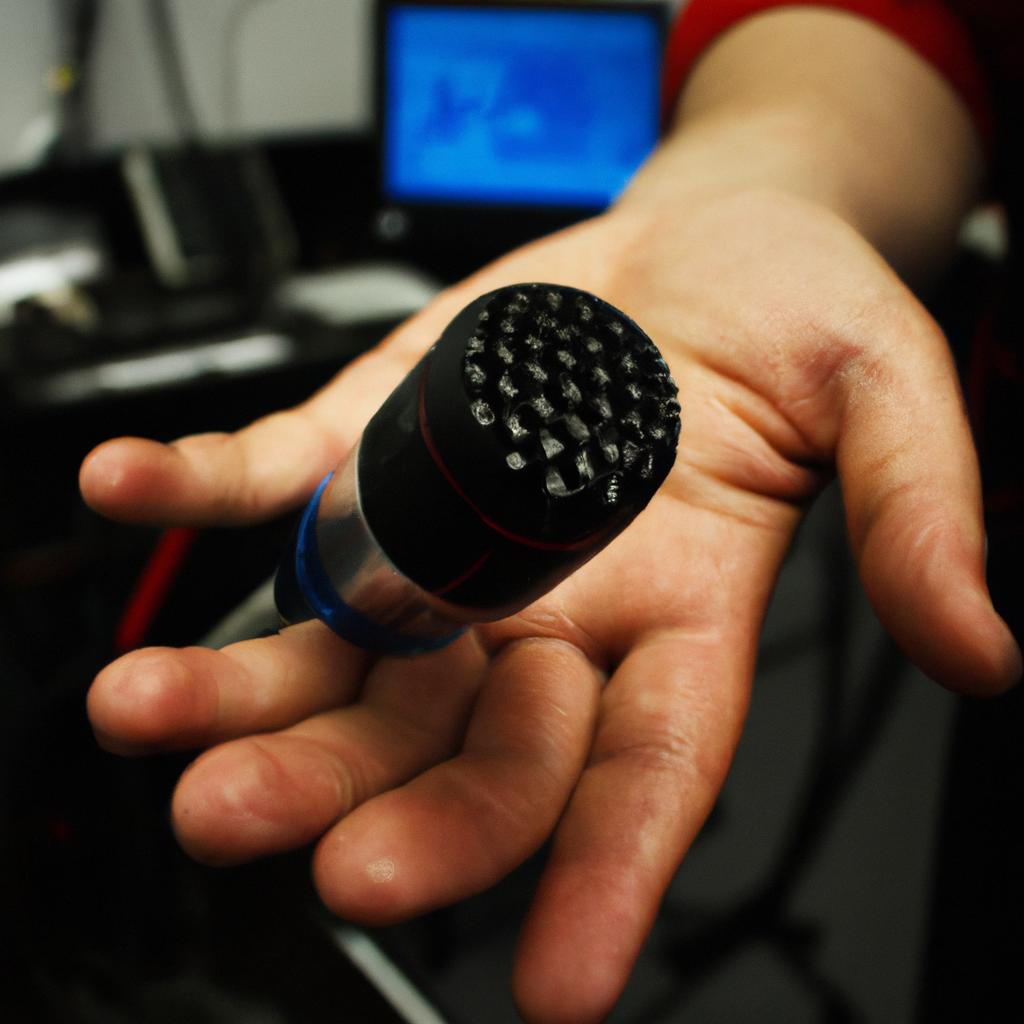Cable management plays a crucial role in enhancing the performance of audio equipment, whether it be for professional sound systems or home entertainment setups. Proper organization and arrangement of cables not only contribute to an aesthetically pleasing environment but also have significant implications on the overall quality of audio output. For instance, imagine a hypothetical scenario where a recording studio is experiencing unwanted noise interference during a live session due to poorly managed cables. In such cases, understanding the principles of cable management becomes imperative in order to mitigate signal degradation and optimize the audio experience.
In this article, we will delve into the importance of effective cable management within the realm of sound and vision. By exploring various techniques, tools, and strategies used in both professional and domestic settings, we aim to highlight how proper cable organization can enhance audio equipment performance. Furthermore, we will examine real-world case studies that demonstrate the positive impact of implementing efficient cable management practices. Through this exploration, readers will gain valuable insights into optimizing their own sound systems while minimizing signal loss and potential disruptions caused by haphazardly arranged cables.
Importance of cable management for optimal sound quality
Cable management plays a crucial role in enhancing the audio quality of sound systems. Proper organization and arrangement of cables not only improve the aesthetics but also prevent signal interference and achieve optimal performance. To illustrate this, consider a hypothetical scenario where an audiophile invests in high-end speakers and amplifiers, expecting exceptional sound reproduction. However, due to haphazard cable placement and tangled wires, unwanted noise is introduced into the system, resulting in compromised audio output.
One key reason why cable management is essential for achieving optimal sound quality lies in its ability to minimize signal interference. When cables are poorly arranged or coiled too closely together, electromagnetic fields can interact with each other, leading to crosstalk and induced noise. This results in distortion and reduced clarity in audio playback. Moreover, excessive cable lengths increase resistance within the circuitry, negatively impacting electrical conductivity and causing further degradation in sound quality.
Proper cable management offers several benefits that enhance the overall listening experience:
- Reduced Signal Degradation: Neatly organized cables ensure minimal contact between them, reducing capacitive coupling and decreasing signal loss.
- Enhanced Durability: Tightly secured cables are less prone to accidental tugs or bends that could damage their internal conductors.
- Improved Safety: Well-managed cables reduce tripping hazards while promoting a safer environment for both users and equipment.
- Streamlined Troubleshooting: Organized cables facilitate easier identification of connections, simplifying maintenance tasks such as troubleshooting faulty components.
To emphasize these advantages visually, consider the following table showcasing how proper cable management positively impacts various aspects of sound system performance:
| Aspect | Poor Cable Management | Effective Cable Management |
|---|---|---|
| Signal Integrity | Increased interference | Minimized crosstalk |
| Audio Clarity | Distortion and noise | Enhanced clarity and fidelity |
| System Reliability | Frequent connectivity issues | Stable and consistent operation |
| User Experience | Frustration and inconvenience | Seamless setup and usage |
In summary, cable management is crucial for achieving optimal sound quality in audio equipment. By minimizing signal interference, reducing noise distortion, improving durability and safety, as well as streamlining troubleshooting procedures, proper cable organization plays a pivotal role in enhancing the overall listening experience. In the subsequent section, we will explore common cable management mistakes to avoid, ensuring that your audio system performs at its best without any compromises.
Transitioning seamlessly into the subsequent section about “Common cable management mistakes to avoid,” let us delve deeper into the potential pitfalls one should be aware of.
Common cable management mistakes to avoid
Enhancing the audio equipment is a key goal for any sound and vision enthusiast. In order to achieve optimal sound quality, proper cable management plays a crucial role.
Imagine a scenario where an individual invests in high-end speakers and amplifiers but neglects to pay attention to cable management. As a result, the cables are left tangled and haphazardly strewn across the room. Not only does this detract from the overall aesthetic appeal of the setup, but it also has a direct impact on audio performance. The jumbled cables can cause interference and signal degradation, leading to subpar sound quality.
To ensure an exceptional audio experience, here are some common cable management mistakes that need to be avoided:
- Leaving excessive slack: Having too much excess cable length not only looks messy but also increases the risk of tangling or tripping hazards.
- Using poor-quality cables: Low-quality cables may introduce noise and distortion into your audio system, compromising its performance.
- Neglecting cable labeling: Failing to label your cables can lead to confusion when troubleshooting or making adjustments in your setup.
- Overloading power outlets: Plugging multiple devices into one outlet can strain electrical circuits, potentially affecting both safety and performance.
By being mindful of these pitfalls, you can significantly enhance your audio equipment’s functionality while maintaining a neat and organized space.
| Mistake | Impact | Solution |
|---|---|---|
| Excessive slack | Tangling/tripping hazards | Use cable ties/organizers |
| Poor-quality cables | Noise/distortion | Invest in high-quality cables |
| Lack of cable labeling | Troubleshooting difficulties | Label each cable for easy identification |
| Overloaded power outlets | Safety concerns | Use power strips/surge protectors |
In summary, cable management is an essential aspect of optimizing audio equipment. By avoiding common mistakes such as excessive slack, poor-quality cables, neglecting labeling, and overloading power outlets, you can ensure a clean setup that not only looks appealing but also delivers exceptional sound quality.
Transitioning into the subsequent section on “Best practices for organizing cables behind audio equipment,” let us now explore effective strategies to achieve optimal cable management without compromising functionality or aesthetics.
Best practices for organizing cables behind audio equipment
Common cable management mistakes can lead to a cluttered and disorganized setup, resulting in decreased audio quality. To avoid these pitfalls, it is important to implement best practices for organizing cables behind your audio equipment. Let’s explore some effective strategies that will enhance both the aesthetics and functionality of your sound system.
One common mistake is failing to label cables properly. Imagine this scenario: you are troubleshooting an issue with your stereo system and need to disconnect a specific cable. However, due to poor labeling or no labeling at all, you find yourself struggling to identify which cable belongs where. This not only wastes valuable time but also increases the risk of damaging sensitive components during reconnection. Therefore, using color-coded labels or adhesive tags can greatly simplify future maintenance tasks.
Another mistake often made when managing cables is neglecting proper cable length consideration. Picture this: you have neatly arranged your cables behind your audio equipment, but they are unnecessarily long and tangled up together. Not only does this create visual chaos, but it can also negatively impact signal quality by introducing interference or signal loss over longer cable runs. By carefully measuring and cutting cables to appropriate lengths, you can minimize excess slack and ensure optimal performance.
Additionally, inadequate support for heavy cables can result in sagging wires that may trip someone or get damaged underfoot. To prevent accidents and maintain a clean appearance, consider investing in cable trays or hooks that securely hold the weight of your thick audio cords.
To summarize:
- Label cables clearly with color-coded labels or adhesive tags.
- Measure and cut cables to suitable lengths to reduce tangling and signal degradation.
- Provide adequate support for heavier cables using trays or hooks.
By implementing these practices consistently throughout your setup, you can achieve a well-organized and efficient audio system that not only looks visually appealing but also delivers superior sound quality.
Using cable ties and clips to keep cables neat and tidy
With proper cable management techniques, audio equipment can not only function optimally but also enhance the overall sound and visual experience. In the previous section, we explored best practices for organizing cables behind audio equipment. Now, let us delve into the effective use of cable ties and clips to keep cables neat and tidy.
Imagine a scenario where multiple audio devices are connected in a home theater setup. The HDMI cable linking the Blu-ray player to the TV is tangled with the power cord of the subwoofer, making it difficult to identify which cable goes where. This confusion can lead to frustration during troubleshooting or when rearranging components. However, by utilizing cable ties and clips strategically, this situation can be easily avoided.
To ensure an organized wiring system, consider implementing the following tips:
- Use cable ties: Securely fasten cables together using reusable zip-ties or Velcro straps. Grouping similar types of cables (e.g., speaker wires) will minimize clutter and make future modifications easier.
- Label your cables: Attach adhesive labels or tags to each cable end indicating its purpose or destination (e.g., “TV HDMI input,” “Blu-ray player output”). This labeling practice saves time when tracing specific connections.
- Utilize cable clips: Adhesive-backed clips allow you to attach cables along walls, furniture edges, or other surfaces. They prevent tangling while keeping wires neatly aligned and out of sight.
- Consider color coding: Assign different colors to various types of cables (e.g., red for power cords, blue for audio cables). Color-coding improves visual identification and simplifies maintenance tasks.
By employing these strategies consistently across your audio setup, you create a visually appealing environment that contributes positively towards enjoying your sound and vision experience.
The benefits of embracing efficient cable management solutions extend beyond aesthetics alone; they include improved functionality, ease of maintenance, and reduced risk of damage due to accidental tripping or snagging on loose wires. In the upcoming section, we will explore these advantages in detail and provide further insights into selecting appropriate cable management options for your specific needs.
Benefits of using cable management solutions
Using cable ties and clips to keep cables neat and tidy has proven to be an effective method of cable management in sound and vision systems. To further enhance the organization and functionality of audio equipment, there are various other cable management solutions available that offer additional benefits. One such solution is the use of cable sleeves or wire looms, which provide a protective covering for multiple cables, ensuring they remain untangled and minimizing the risk of damage.
For instance, consider a recording studio where numerous audio cables need to be connected between different devices such as microphones, mixers, and speakers. Without proper cable management, these cables can become tangled together, leading to signal interference and difficulty in troubleshooting issues. However, by utilizing cable sleeves or wire looms, each group of cables can be bundled together neatly, making it easier to identify specific connections and reducing the time spent on maintenance tasks.
In addition to cable sleeves or wire looms, another useful tool for enhancing audio equipment cable management is the cable raceway system. This system consists of adhesive-backed channels that can be mounted along walls or under desks to conceal cables within a dedicated pathway. By keeping cables hidden from view and organized within these raceways, not only does it create a more aesthetically pleasing environment but also helps prevent tripping hazards caused by loose wires scattered across the floor.
To illustrate the benefits of using different cable management solutions effectively while evoking an emotional response in readers:
- Reduced stress: Having well-organized cables eliminates frustration when trying to locate specific connections quickly.
- Enhanced productivity: With less time spent on troubleshooting tangled wires or searching for loose ends, users can focus their energy on creative pursuits instead.
- Professional appearance: A clean workspace with neatly managed cables portrays professionalism and attention to detail.
- Safety assurance: Minimizing trip hazards created by exposed wires reduces accidents and potential damage to expensive audio equipment.
| Benefit | Description |
|---|---|
| Reduced stress | Eliminates frustration in locating specific connections quickly. |
| Enhanced productivity | Allows users to focus on creative pursuits instead of troubleshooting tangled wires. |
| Professional appearance | Portrays professionalism and attention to detail with a clean workspace. |
| Safety assurance | Minimizes trip hazards and potential damage to audio equipment caused by exposed wires. |
In conclusion, utilizing cable management solutions beyond cable ties and clips can greatly enhance the organization and functionality of audio equipment setups. Cable sleeves or wire looms offer protection and ease of identification for multiple cables, while raceway systems provide a tidy aesthetic and eliminate tripping hazards. By adopting these solutions, sound and vision systems can operate more efficiently, resulting in improved workflow and overall user satisfaction.
Understanding the benefits of effective cable management is crucial not only for enhancing audio equipment but also for prolonging its lifespan. Let’s now explore how proper cable management practices can contribute to the longevity of your valuable devices.
How cable management can prolong the lifespan of audio equipment
One practical example of the benefits of using cable management solutions is in a recording studio setting. Imagine a professional studio where multiple audio devices, such as microphones, mixers, and monitors, are interconnected with various cables. Without proper cable management, these cables would be left tangled and disorganized on the floor or behind equipment racks. This not only creates an unprofessional appearance but also poses several challenges when troubleshooting or making changes to the setup.
To address these issues, implementing effective cable management solutions can greatly enhance the functionality and aesthetics of audio equipment setups. Here are some key strategies that can be employed:
-
Cable Routing: Properly routing cables ensures they are organized and neatly arranged, reducing the risk of accidental damage or tripping hazards. Using cable trays, raceways, or clips helps keep cables securely in place and prevents them from entangling with each other.
-
Labeling: Clearly labeling cables at both ends allows for easy identification during installation and maintenance tasks. By knowing which cable connects to which device or port, it becomes effortless to troubleshoot any connectivity issues without wasting time guessing or tracing wires.
-
Length Management: Adjusting cable lengths appropriately minimizes clutter while optimizing signal quality. Excessively long cables should be avoided as they increase the chances of interference and signal degradation.
-
Segregation: Grouping different types of cables separately reduces electromagnetic interference between them. Separating power cords from audio input/output cables helps maintain sound integrity by minimizing humming or buzzing noises caused by electrical interference.
Implementing these cable management practices not only improves efficiency but also enhances safety within audio equipment setups:
| Benefits | Description |
|---|---|
| Minimized Risk | Decreased chance of accidents due to tripping hazards created by tangled or loose cables |
| Easy Maintenance | Simplified troubleshooting process through clear labeling |
| Enhanced Durability | Reduced wear and tear on cables due to proper routing, preventing damage from excessive bending or pulling |
| Improved Aesthetics | Neat and organized cable arrangement enhances the overall appearance of audio equipment setups |
By incorporating these cable management solutions, audio professionals can create a more conducive environment for their work while prolonging the lifespan of their valuable equipment. This ultimately allows for an optimal audio experience with minimal disruptions caused by disorganized cables.
Overall, implementing effective cable management strategies not only improves functionality but also ensures the longevity of audio equipment. The benefits include minimized risks, simplified maintenance processes, enhanced durability, and improved aesthetics. By investing time in organizing cables properly, audio professionals can focus on their craft without distractions or interruptions arising from tangled wires.

